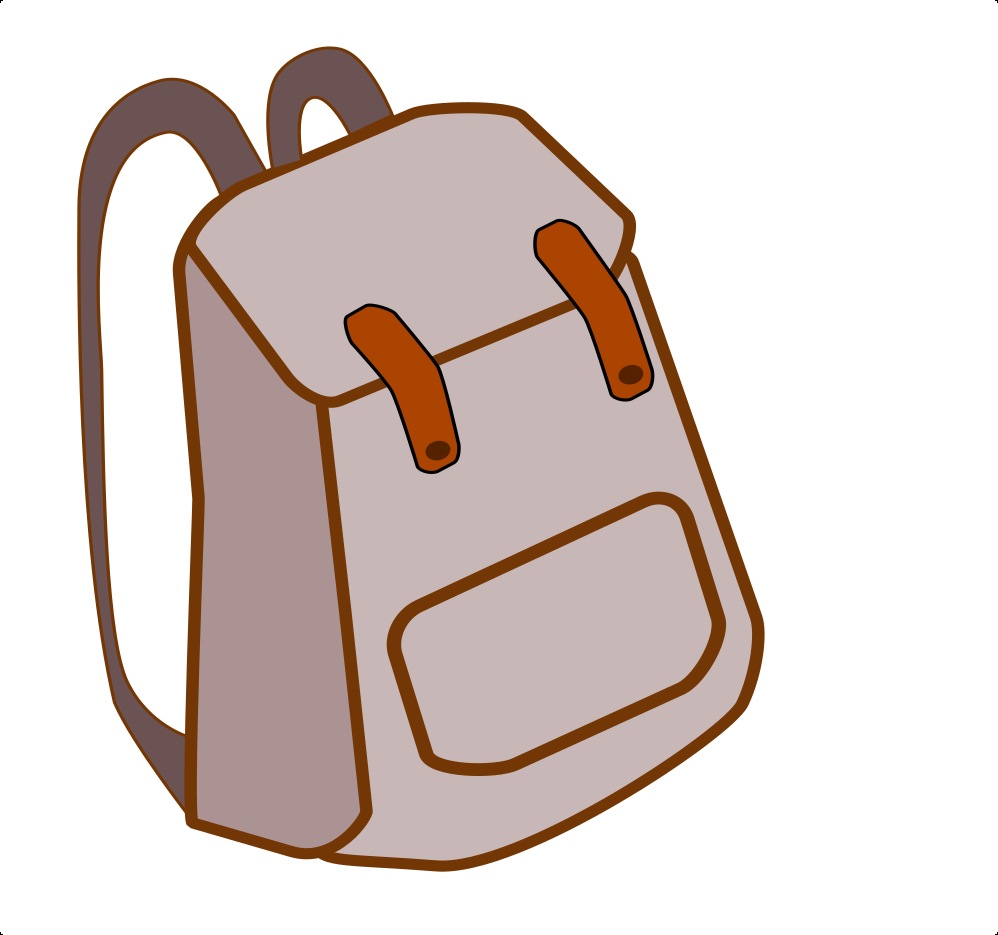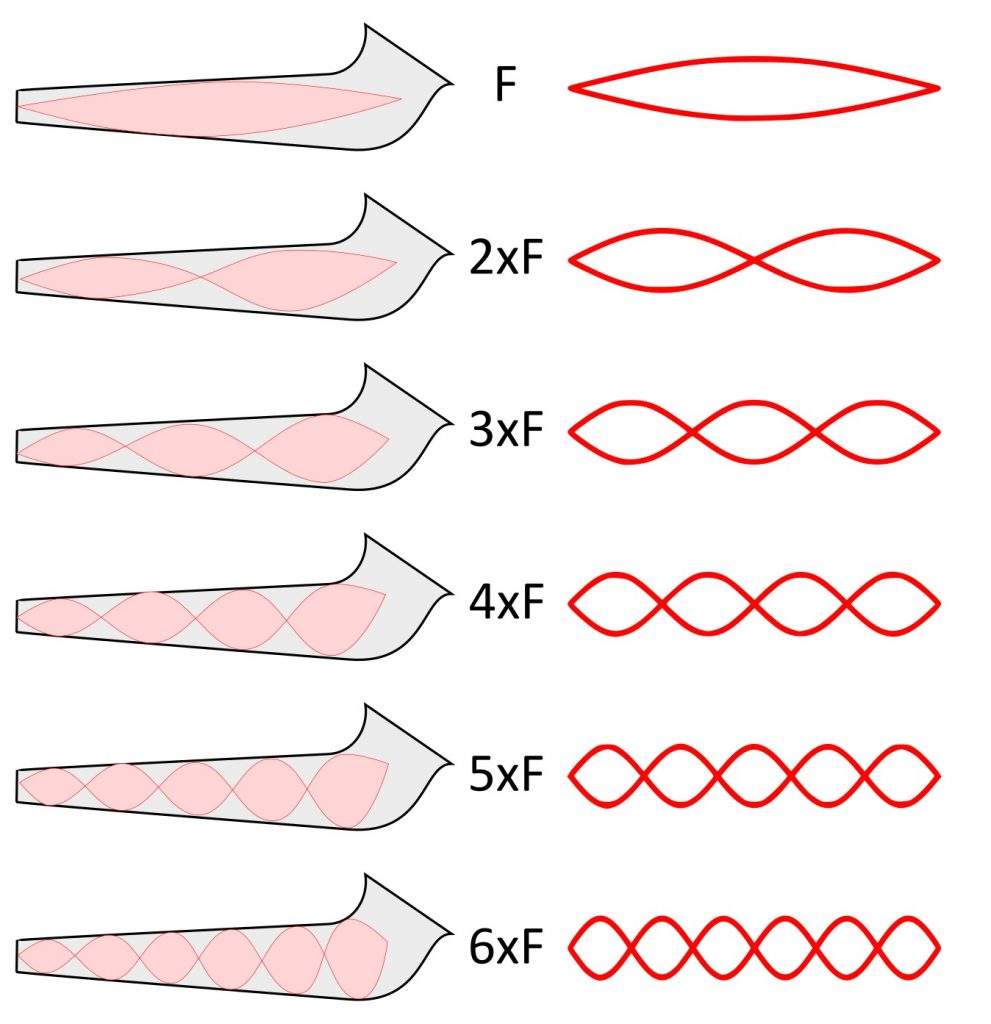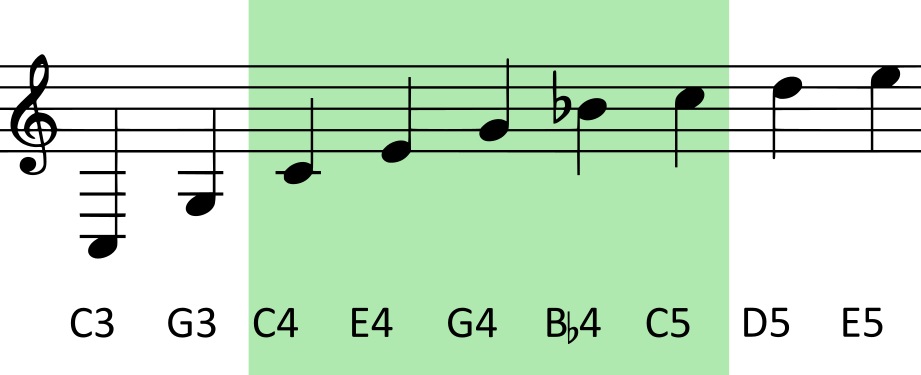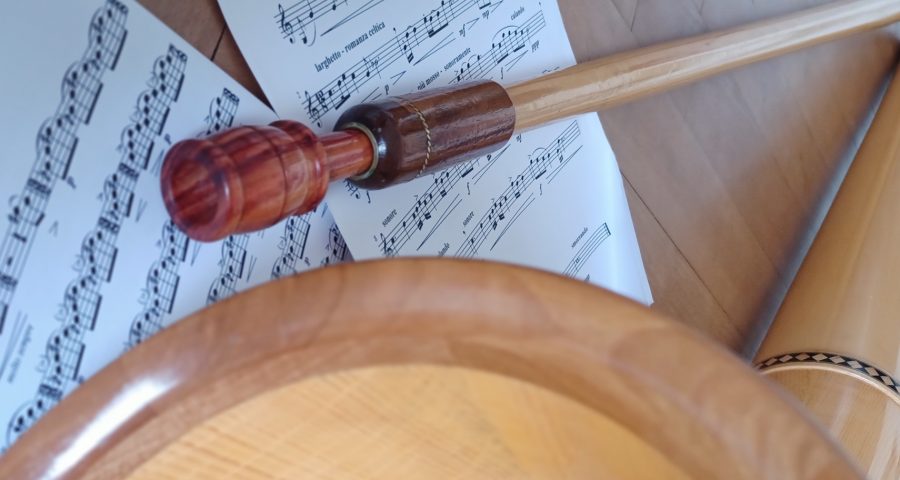Preliminary remarks on lessons 3-5: This is the second part of this course. You will learn the technical basis of blowing the alphorn – embouchure, breathing, posture. You work on the quality of sound and accuracy, and expand your range. By the end of this part you will be familiar with sheet reading and the natural scale. Allow 2-6 months for this part.
In this lesson you will learn to play tones from notes.
 Reading Sheet Music
Reading Sheet Music
You are familiar with the treble clef staff? You know the meaning of accidentals, note values, time signatures, slurs, fermatas? You understand staccato, piano, forte, adagio, and allegro? If so, you can skip this section.
Do you absolutely need notes to learn the alphorn? No, not necessarily. The stocky “Ur-Senn” who is often mentioned, who played his horn at sunset in the mountains, certainly played without sheet music. The alphorn is also ideal for solo improvisation. However, notes are essential for conveying melodies and musical knowledge or as a basis for playing together. In the following chapters I will use notes again and again. You should therefore acquire the necessary basic knowledge – the small effort (5-10 hours of study should be enough) is worth it! There are numerous online courses (e.g. here), YouTube videos (e.g. here or here), or book (e.g. here) teaching the basics of music theory. Due to the demand for an alphorn-specific introduction, I have written a corresponding appendix here.
 Playable tones
Playable tones
Experiment: Sing a tone with low pitch; then gradually increase the pitch until you reach a high register. Then do the same, singing into your alphorn (without the mouthpiece). What is happening?
When you gradually adjust the pitch while singing in your instrument, you will notice that the tones tend to “jump”. This is the result of the acoustic properties of your conical tube. Apparently the alphorn only allows certain tones, namely the harmonics of your fundamental (i.e. the bass F if you happen to own an alphorn in F). Overtones and harmonics are tones whose frequency is a multiple (N, in integers) of the frequency of the fundamental (F). The first harmonic is the fundamental itself (1xF), the second harmonic (also called the “first overtone”) is twice the frequency of the fundamental (2xF), the third harmonic (alias “second overtone”) is three times the frequency of the fundamental (3xF), and so on. If you play the harmonics of a fundamental one after the other, you hear the “natural series”. In other words: you can only play the tones of a natural scale on the alphorn!
Think of the tones as vibrations in the alphorn. The length of the alphorn corresponds exactly to one vibration of the fundamental tone, two vibrations of the second harmonic, three vibrations of the third harmonic, etc. See the graphic below. In the left part you can see the air vibrations in the alphorn. At the top is the fundamental, then the second harmonic, etc. If you pluck a string on a guitar, overtones also oscillate with the fundamental (right part of the graphic).

You can transfer the harmonics – i.e. the natural scales – to musical notation like this:

These are the notes you can play on the alphorn. In other words: all notes that are not shown in this chart cannot be played! Normally you move in the range C3 to G5. The area shaded in red, i.e. the root C2 and all tones above G5, is reserved for experienced alphorn players (some people can also play higher than C6, by the way). And this is how it sounds on the alphorn:
You probably find the natural scale a bit unfamiliar. Above all, the 11th harmonic – the so-called “alphorn Fa” – sounds weird to our ears. But other tones, such as the 7th harmonic B-flat 4, deviate audibly from the usual intonations. These special pitches make up the character of the alphorn! Disdained or even banned just a few decades ago, they are now used consciously and prominently.
![]() Further information
Further information
- This video by Andrew Huang explains the harmonic series in more detail – including a digression into additive synthesis. Also check out this cool github page that allows you to play with harmonic series (click on the strings to trigger the sound).
- Going beyond harmonics, this video with Adam Neely shows the direct links from the natural scale to polyrhythms and colors.
 Exercises
Exercises
Objective: You can play simple melodies from sheet music.
Download the etude collection of Exercises for beginners. As a supplement or alternative, I recommend booklet Schafkopfen by Georg Haider (of course you can also use other practice material such as the Alphornschule 85 or the Méthode de Cor des Alpes). The exercises in the collection are divided by range and then arranged in ascending difficulty within each range.
Before you get started, you need to determine your own range – the notes you can blow cleanly. You can do this with a tuning fork, a piano, or with a tuner app on your phone (don’t forget to tune the app to your alphorn’s tuning; e.g. in Cleartune you need to go to the settings and set the “ransposition to the tuning of your alphorn). If you want, you can also refer to the following audio snippets:



Start with the first exercise corresponding to your range. Instructions:
- Begin to play each exercise freely, then take the metronome. The metronome forces you to be precise.
- Always play with a lot of air, because your alphorn doesn’t sound without air! Play all notes clearly. Rather miss a pitch rather than playing hesitantly! (“Do it wrong but do it strong!”)
- If you struggle with a section of an exercise, focus on that section.
- Start slowly (@60bpm – i.e. 60 beats per minute – or even slower). Only when you can play the exercise safely do you increase the tempo. Keep it moderate, it’s not a speed exercise.
- Spend 5-10 minutes a day on one exercise. For longer exercise blocks, add additional exercises.
- When you master an exercise, keep playing it for 2-3 days. During this time, begin the next exercise.
- Regular practice will automatically expand your range. At first, the next higher or lower note succeeds uncertainly, then it becomes more and more reliable and stable. Begin with the exercises in the new range as soon as you are reasonably sure of hitting the new pitches. But don’t get stressed! Try to blow the new note with conviction; if he doesn’t come, don’t press! You learn more when you solidify your range with clear and clean tones than when you’re forcing your pitch limits.
From now on, practice on these etudes every day. This also applies to lessons 4 & 5 – only in chapter 6 do you start with new practice plans.
 Just intonation and equal temperament
Just intonation and equal temperament
Why do you get goose bumps when you hear an alphorn chorale? The reason for this lies in the overtones. In the illustration above you have seen that with a guitar, for example, the string also vibrates in the frequency of the overtones in addition to the fundamental frequency. You can observe this phenomenon with all musical instruments, including the alphorn. It is the combination of the tone with its overtones that make up the sound. Only an (electronically generated) sine tone has no overtones. In the following video you can see the connection between overtones and timbre:
What is special about the alphorn is that all playable tones correspond exactly to the harmonics of the fundamental tone (NxF). All overtones of the playable tones (nxNxF) are also overtones of the fundamental. With a cleanly intoned alphorn chorale, the different voices merge into a full sound – the goose bump factor!
The fact that the natural scale still sounds strange to our ears is solely due to the fact that we have been conditioned to a harmonically “wrong” tuning for four hundred years. The keyboard instruments are to blame! Because of them the old masters had to look for a tuning method with which different keys could be played on a limited number of keys. After various attempts (perhaps you have heard of Bach’s Well-Tempered Piano) the equal temperament prevailed. In this case, each octave is mathematically divided into twelve semitones that are exactly the same distance apart (the frequency ratio between two semitones is 1:1.059463 – mathematically the twelth root of two). This equal temperament is not compatible with the natural scale. In the graph below you can see the deviation in cents; a cent is 1% of a semitone. In the playable range, the Fa is particularly noticeable, which is 49 cents below F sharp, so almost exactly halfway to F. The B flat also sounds clearly lower than the corresponding tones in the equal temperament. The A5 is also noticeable in the uppermost area (often notated as A flat as it is actually closer to A flat of the equal temperament). Only the C (C2 to C5) match exactly.

Here a direct comparison of equal temperament and the clean harmonics (also called “just intonation”):
Equal temperament has many advantages. In particular, it enables great harmonic flexibility. Guitar riffs with cool chord progressions, complex modulations in classical music or rapidly changing harmonies in jazz only work thanks to equal tuning. Flexibility explains the triumph of equal temperament in western music. This is so absolute that even the most professionally trained musicians today have no idea about other tunings. It is forgotten that we bought the flexibility by losing the perfect harmony. The price shows itself in the form of beats in chords in equal temperament. It’s not your alphorn that sounds weird, but the other instruments – even if hardly anyone hears that anymore!
That’s why playing together with other instruments is so challenging for alphorn players. You can only play the tones of the natural scale, and they don’t even really match the tones of the other instruments. Due to the smaller tonal material, you only have two modes (C major and G minor) available, while the music on other instruments thrives on harmonic changes. All this does not mean that an interaction would be impossible. But it requires a minimum of mutual understanding, which you usually have to convey as the “exotic” instrument in the room. However, in practice the difference is not that dramatic. The pure harmonic frequency ratios derived above can only be approximately achieved on the real existing alphorn. Every alphorn deviates more or less from the harmonic series. Your intonation always plays a decisive role: with your embouchure you have an important influence on the pitch.
Another addendum: you may have heard of the 432Hz tuning. This is not a tuning system, but the reference point of the concert pitch. The standard a1 = 440Hz has been in force since 1939; 442Hz is now common in Switzerland (accordingly, the fundamental tone of the F horn is 88Hz and the F# horn is 93Hz). Some believe – without wanting to explain the esoteric details here – the correct concert pitch should actually be 432Hz. If you want to tune your alphorn to the standard pitch 432Hz, you can buy an appropriate adapter; I doubt this will improve the sound quality of your horn, but it may give you the overtones of cosmic vibrations.
![]() Further information
Further information
- There are many excellent videos available on the topic of just intonation versus equal temperament. See for example the Brief History of Western Tuning by Nathan Nokes
- Ross W. Duffin (2008). How Equal Temperament Ruined Harmony (and Why You Should Care). The most cited classic on the subject of equal temperament.
- Aindrias Hirt (2014). The European Folk Music Scale: A New Theory. Hirt theorizes that the use of the natural scale distinguishes European folk music from art and sacred music.
- More recently, some musicians have grappled with the different tunings. Here is an interesting platform to get started with this “microtonal” or “xenharmonic” music.
- When it comes to tuning, there are strong parallels between the alphorn and Indian classical music – in fact, they would agree that Western tuning sounds wrong. See this video by Sangeeta Shankar explaining the difference between equal temperament and indian shrutis.
- Here a fun vlog post by Adam Neely on the 432Hz concert pitch. Here my own post on this topic.
- A very well done introduction to the acoustics of brass instruments can be found here.
